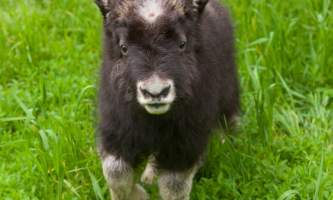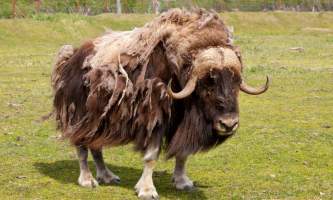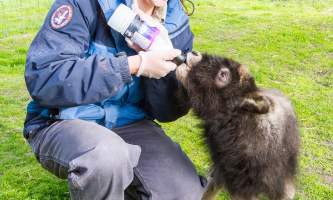Musk Ox
Here we are at the musk ox habitat at the Alaska Wildlife Conservation Center.
Musk oxen are closely related to sheep and goats, and therefore establish dominance in much the same way. Typically, males will ram their heads together in a spectacular display of “I’m bigger than you are,” and can be witnessed at the AWCC in the fall rutting season.
Male musk ox will square up from 50 to 100 yards apart from one another and reach top speeds just prior to ramming heads. Male musk ox will fight for dominance over a harem of females or a herd of musk ox. The closest comparison we have to this collision is a small to mid-size car running into a concrete barrier just under 20 miles an hour. It’s fairly loud and can catch you off guard if you’re not prepared for it.
If dominance does not get figured out on the first hit, the males do not remain in close combat. They will simply order a rematch on the spot and repeat the process.
Not to worry, though, these fellas are made for this. Males have what’s called a “boss” in the middle of their head where the horns meet. Coincidently not only where their own personal horns meet, but this area also becomes the battering ram as it also meets horn “bosses” from other males. The horn itself can be upwards of 4” thick followed by up to 3” of skull thickness; that’s 7” of bone crushing power just to “get the girl.”
Another interesting adaptation for musk ox is their fur. This is a very rare fiber (only found on musk ox) and is relatively 8 times warmer than sheep’s wool but softer than cashmere. The underfur of the muskox is called qiviut. Qiviut is one of the warmest natural fibers on Earth. Due to their thick fur, the apparent size of muskoxen is deceiving. At birth, calves weigh 20 to 30 pounds. Adult cows weigh 300 to 400 pounds, while mature bulls weigh 600 to 800 pounds.
As far as food goes, muskoxen are strict herbivores feeding on a wide variety of tundra plants. Grasses, sedges, crowberry, avens, and the leaves and twigs of willow and dwarf birch are favorite food items. The herd at the AWCC are supplemented with a pelleted ration specifically made for the nutritional needs of musk ox. We also feed alfalfa hay as well as local brome hay to help fill their tummies between summer seasons and full fields of delicious green grasses.




